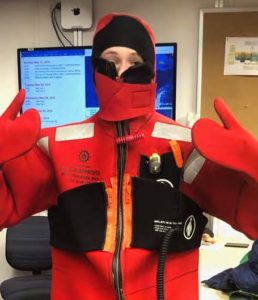Rebecca Smith ’12 researching prehistoric climate change to better predict the world to come
For most of us, visiting a beautiful setting in Maine means taking in the views, basking in the sun, and perhaps looking out for local wildlife. Becky Smith thinks a bit differently. When she’s out in the natural world, she’s more interested in knowing what that particular spot looked like millions of years ago.
 Becky’s interest in science first emerged in Waynflete’s Astrophysics and Marine Biology electives. Becky credits these two courses—taught by educators David Vaughan and Wendy Curtis—with sparking her fascination with earth science. Alice Brock had also inspired a passion for Russian history, which led Becky to consider pursuing the subject at the college level. Bates College offered her a soccer recruitment, however, and since the school didn’t offer a Russian history program, Becky decided to study geology.
Becky’s interest in science first emerged in Waynflete’s Astrophysics and Marine Biology electives. Becky credits these two courses—taught by educators David Vaughan and Wendy Curtis—with sparking her fascination with earth science. Alice Brock had also inspired a passion for Russian history, which led Becky to consider pursuing the subject at the college level. Bates College offered her a soccer recruitment, however, and since the school didn’t offer a Russian history program, Becky decided to study geology.
During her time at Bates, Becky conducted fieldwork in the deserts of California, Nevada, Texas, and Mexico, eventually moving into a more intensive form of field mapping in Montana, where she measured the age and spatial distributions of rock formations in specific areas. (The resulting maps reveal how a region has changed over geologic time—millions to billions of years.) While energy companies conduct this type of research when searching for new oil fields, Becky was in it purely for the science. “It was such a new experience, and I just loved it,” she recalls.
Becky’s undergraduate work also focused on coprolites (fossilized feces), particularly those left behind thousands of years ago by now-extinct giant sloths. By examining coprolites, researchers can reconstruct details of the environment in which the sloths once lived. Becky was intrigued. “This was just the coolest thing,” she says. “I began to realize that I was truly curious about what Earth looked like millions of years ago.”
After earning her geology degree, with supplemental coursework in geochemistry and paleobiology, Becky entered the graduate program at the University of Massachusetts at Amherst. She began to research the fossilized remains of ancient phytoplankton in order to reconstruct changes in ocean currents through time.
Phytoplankton, which are responsible for generating half of the planet’s oxygen, are microscopic organisms that live in the surface ocean. When these tiny marine creatures die, their organic compounds descend to the ocean floor, where they leave behind a lipid (oil) residue. Over millions of years, these organic compounds—known as biomarkers—accumulate in layers of sediments on the ocean floor. Since phytoplankton adjust their chemical compositions to different ocean temperatures, lipids from warm surface waters contain different organic compounds from those produced in cold waters. By extracting lipid samples from marine sediments, paleoclimatologists and biogeochemists can learn about the ocean temperatures in which the source organisms once lived. These lipids, which are collected every few centimeters from deep-sea marine sediment cores, allow scientists to reconstruct how sea surface temperatures have changed over millions of years. “It’s intriguing work,” Becky says. “By studying these periods, we will be able to better understand baseline climate behavior on Earth, which improves the climate models capable of predicting where we’re heading in the future.”
 Becky recently completed a nine-week research expedition in the Central South Pacific as part of the International Ocean Discovery Program. The JOIDES Resolution, a 470-foot-long research vessel, sailed to the area of the Antarctic Circumpolar Current (ACC), the only ocean current on Earth unimpeded by continents. The ACC moves rapidly around Antarctica, mixing and redistributing currents and heat between the Pacific, Atlantic, and Indian Oceans. “The ACC essentially works as a gigantic mixing bowl, pumping ocean currents around the world,” says Becky. “It has a substantial influence on global climate.”
Becky recently completed a nine-week research expedition in the Central South Pacific as part of the International Ocean Discovery Program. The JOIDES Resolution, a 470-foot-long research vessel, sailed to the area of the Antarctic Circumpolar Current (ACC), the only ocean current on Earth unimpeded by continents. The ACC moves rapidly around Antarctica, mixing and redistributing currents and heat between the Pacific, Atlantic, and Indian Oceans. “The ACC essentially works as a gigantic mixing bowl, pumping ocean currents around the world,” says Becky. “It has a substantial influence on global climate.”
The ACC had until recently been considered too remote for study by geologists (the region is well known as one of the stormiest places on the planet). Despite these challenges, core drillers deployed over three miles of piping from the ship’s drilling rig down to the ocean floor, then penetrated a further 300 meters down to extract ancient sediment samples. The crew often had to conduct its precise work in rough seas. “The analogy the drillers use is hitting a dime with a piece of string from the top of the Empire State Building, “ says Becky. “It’s remarkable what they’re able to do.”
While Becky did complete some initial analyses in the ship’s chemistry lab, the real work begins onshore. In January 2020, Becky and her colleagues will gather for a “sampling party” at Texas A&M University. Each scientist will collect samples from the specific cores that interest them, then bring them back to their home universities for analysis. Though they will use these core samples to independently test their hypotheses, researchers will continue to collaborate, staying in regular contact through videoconferencing.
The scientists’ efforts will eventually result in the production of a complete climate record of the central South Pacific—and the dynamics of the ACC—over the past five to eight million years. These studies will provide crucial information for climate modelers to reconstruct periods in Earth’s history under similar-to-modern CO2 conditions. In order to understand where climate is heading under the influence of humans, models need to incorporate information on how Earth functions on a long-term scale.
In her work with fellow scientists from around the world, Becky has learned that the United States is one of the few countries where there is any significant skepticism about climate change. “Irrespective of personal opinions, change is already happening,” she says. “And it’s the people living in poor coastal communities—those who have no voice and no financial means to adapt—who are already being displaced due to rising ocean levels.” Many denialists argue that climate change is cyclic—that CO2 varies over long timescales, and that what we see today is nothing out of the ordinary. While climate change does follow cyclic patterns, scientific data has shown a massive deviation from normal cycles since the onset of the Industrial Revolution. In the context of natural cyclicity, the Earth should actually be entering a glacial period. “Humans are causing global warming at a speed that is unprecedented,” Becky says. “Most species are not able to adapt to this rate of change.” Global warming is not about damaging the Earth, which is actually very resilient. “It’s the destruction of species and ecosystems that should really worry us.”



